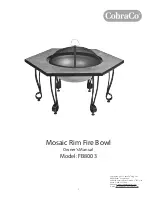
LP-446-r4 Rev. 10.12.16
40
Part 8 - Start-Up Preparation
A. Check / Control Water Chemistry
Chemical imbalance of your water can cause severe damage
to your boiler and associated equipment, and may also
affect efficiency. You may have to have your water quality
professionally analyzed to determine whether you need to
install a water softener. It is important that the water chemistry
on both the domestic hot water and central heating sides are
checked before installing the boiler, as water quality will affect
the reliability of the system. Outlined below are those water
quality parameters which need to be met in order for the
system to operate efficiently for many years. Failure of a heat
exchanger due to lime scale build-up on the heating surface,
low pH or other imbalance IS NOT covered by the warranty.
To assure extended service life, it is recommended to test water
quality prior to installation. Listed below are some guidelines.
Do not use petroleum-based cleaning or sealing compounds in
the boiler system. Damage to elastomer seals and gaskets in the
system could occur, resulting in substantial property damage.
Sodium less than 20 mGL
Water pH between 6.0 and 8.0
1. Maintain boiler water pH between 6.0 and 8.0. Check with
litmus paper or have it chemically analyzed by a water treatment
company.
2. If the pH differs from above, consult local water treatment
company for treatment needed.
Hardness less than 7 grains
Consult local water treatment companies for unusually hard
water areas (above 7 grains hardness).
Chlorine concentration less than 100 ppm
1. Using chlorinated fresh water should be acceptable since
drinking water chlorine levels are typically less than 5 ppm.
2. Do not connect the boiler to directly heat a swimming pool or
spa water.
3. Do not fill boiler or operate with water containing chlorine in
excess of 100 ppm.
Hardness:
Less than 7 grains
Chloride Levels:
Less than 100 ppm
pH Levels:
6-8
TDS:
Less than 2000 ppm
Sodium:
Less than 20 mGL
B. Check for Gas Leaks
Before starting the boiler, and during initial operation, smell
near the floor and around the boiler for gas odorant or any
unusual odor. Remove boiler front door and smell interior of
boiler enclosure. Do not proceed with startup if there is any
indication of a gas leak. Repair any leaks at once.
PROPANE BOILERS ONLY – The propane supplier mixes an
odorant with the propane to make its presence detectable. In
some instances the odorant can fade, and the gas may no longer
have an odor. Before startup (and periodically thereafter), have
the propane supplier verify the correct odorant level in the gas.
C. Condensate Removal
1. The boiler is a high efficiency condensing boiler. Therefore,
the unit has a condensate drain. Condensate fluid is nothing
more than water vapor, derived from combustion products,
similar to that produced by an automobile when it is initially
started.
Condensation is slightly acidic (typically with a pH of 3 to 5)
and must be piped with the correct materials. Never pipe the
condensate using steel, copper, brass or other materials that
will be subject to corrosion. Plastic PVC or CPVC pipe are the
only approved materials.
A condensate neutralizer, if required by local authorities,
can be made up of lime crystals, marble or phosphate chips
that will neutralize the condensate. This may be done by the
installer or you may purchase a condensate neutralizer from
HTP (7350P-611).
2. The boiler is equipped with a ¾ female socket weld fitting
connection that must be piped to a local drain. It is very
important that the condensate line is sloped downward away
from the boiler to a suitable inside drain. If the condensate
outlet on the appliance is lower than the drain, you must use a
condensate removal pump, available from HTP (554200). This
pump is equipped with two leads that can be connected to an
alarm or another type of warning device to alert the user of
a condensate overflow, which, if not corrected, could cause
property damage.
3. If a long horizontal run is used, it may be necessary to create
a vent in the horizontal run to prevent a vacuum lock in the
condensate line.
4. Do not expose the condensate to freezing temperatures.
5. It is very important you support the condensation line to
assure proper drainage.
D. Final Checks Before Starting Boiler
1. Read Startup Procedures within this manual for proper
steps to start boiler. (See Startup Report to record steps for
future reference.)
2. Verify the boiler and system are full of water and all system
components are correctly set for operation.
Ensure the boiler is full of water before firing the burner.
Failure to do so will damage the boiler. Such damage IS NOT
covered by warranty, and could result in property damage,
severe personal injury, or death.
3. Fill condensate trap with water.
4. Verify electrical connections are correct and securely
attached.
5. Inspect exhaust vent and intake piping for signs of
deterioration from corrosion, physical damage or sagging.
Verify exhaust vent and intake piping are intact and correctly
installed per Venting Section and local codes.
E. Setting Up a Single Boiler
When power is applied to the boiler, the control first
completes a power-up systems check. During this time the
combustion fan may run. The display will initially show the
current boiler outlet temperature. If a fault is detected during
the power-up test, the control will display the appropriate
fault code. Otherwise, the display will continue to show the
Summary of Contents for MODCON500
Page 35: ...LP 446 r4 Rev 10 12 16 35 Figure 29 Cascade Master and FollowerWiring...
Page 57: ...LP 446 r4 Rev 10 12 16 57 Figure 35 500 Model Combustion System Replacement Parts...
Page 58: ...LP 446 r4 Rev 10 12 16 58 Figure 36 700 850 Models Combustion System Replacement Parts...
Page 60: ...LP 446 r4 Rev 10 12 16 60 Figure 38 Cabinet Replacement Parts All Models...
















































